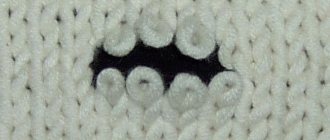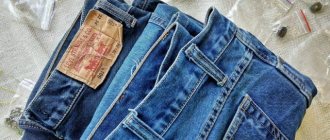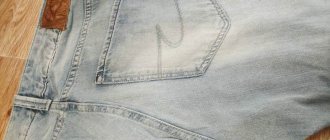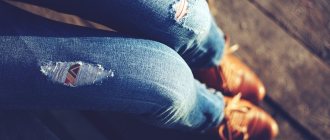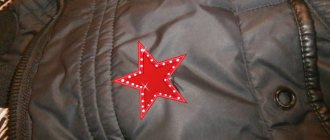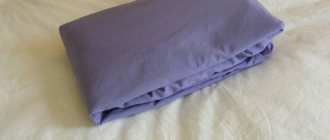Where are jeans most likely to fray and tear?
The main reason is the deterioration of the fabric. If you wear the same thing for a very long time, sooner or later abrasions will appear. The fibers become thinner, and then the hole is not far away. Such damage appears: between the legs, on the knees, along the lower edge of the trouser legs, along the edges of the front pockets.
Reasons why gaps appear between the legs:
- fabric - jeans with artificial elastane threads wear in less frequently than trousers made of 100% denim. Natural fibers tear easily and spread along the seam;
- body features - excess volume in the hips or inflated leg muscles contribute to rapid wear of the fibers when walking. If there is no gap between the legs, the jeans are rubbed along the entire length;
- manner of walking - when walking, when the legs rub against each other, holes appear not only between the thighs, but also in the knees.
Do not miss
- Do not miss
Good as new: 7 ways to sew up a hole in a jacket so that the seam is not visible (video)
Types of ripped jeans
Artificially creating holes in old jeans is a way to restore things. They are:
- large – open the knee or most of the leg;
- narrow - detected when moving due to tissue tension;
- in the form of a patch - closed with threads and material.
Lace holes on jeans
To create them, light guipure or any other lace fabric is hemmed into the gap area. This can be done from the inside of the pant leg or over the hole. It is desirable that the threads match the color of the insert.
This method allows you to soften the appearance and cover open parts of the body.
Irregular shape
Non-standard shaped slits will help restore an acceptable look to old jeans; they are especially suitable for representatives of subcultures and creative people. Process step by step:
- chalk out up to 8 cross-sections located one below the other in accordance with the chosen shape or figure;
- cut through the fabric, placing cardboard or plywood;
- randomly pull out the white and partially colored threads, leaving the base.
Big holes
They promote air circulation in hot weather, but are uncomfortable in cool weather. Horizontal and vertical cut lines are marked on the trouser legs, and part of the fabric is cut out. It is preferable to process the edges in large holes - this way the item will last longer.
Men's legs do not look very aesthetically pleasing in such pants.
Scuffs or aging effects
The lightening and shabby look is obtained as follows:
- Using pumice. Rub it on the designated areas.
- Fine sandpaper. It is important not to overdo it and preserve the white threads. If they are damaged, they cannot be restored.
- By soaping and scrubbing the area for a long time with a brush. Quite a labor-intensive process.
- By soaking in chlorine bleach, such as White. The product is applied locally and left for 3-4 hours. There is a risk of unintended areas becoming discolored due to accidental chemical exposure, as well as holes being created if the fabric is thin.
Torn bottom
Fringes are made along the worn edges of old denim pants. This is how you can restore the neat appearance of the fabric:
- turn a thing inside out;
- tear off the hemmed edges;
- determine the starting point of the fringe;
- cut lines vertically at a distance of 2 cm from each other;
- pull out horizontal threads with tweezers or a needle;
- stitch the edge so that the fabric does not unravel further.
How to sew a hole in jeans manually: techniques
There are several techniques for repairing pants without a sewing machine. Each of them depends on the location of the damage.
How to mend jeans without being noticed
The point of darning is to replace worn out fibers with new threads. For repair, they are selected as similar in color and thickness as possible. It would be nice to use threads from the same trousers (they can be carefully removed from the folded part of the trousers). Or buy special threads for darning or embroidery floss.
Worn parts that require darning appear between the legs due to friction when walking. What you need to do: lay it out tightly on a flat surface, fix the thread on a strong part of the fabric, make horizontal stitches over the worn fibers.
After this, go through vertical stitches so that the thread passes between the horizontal row. If you do it slowly and carefully, the darning area cannot be distinguished from the rest of the trousers.
Plastering denim fabric
This technique is suitable if your jeans have been cut by a sharp object or a nail. The most common technique when working with denim.
First you need to apply a vertical row, then go through horizontal stitches, threading the thread between the fibers. You can also form stitches diagonally. Plastering is reminiscent of darning, the difference is that the stitches are not made along the old fibers, but over the hole.
How to sew jeans with a blind seam
This technique is good to use when trousers are torn at the seam. For example, the threads may come apart due to tension in the buttock area or on the side. It happens that part of a pocket or a loop on a belt comes off. A hidden seam will do the job; there will be no trace left of the hole. The same trick is used if you need to hem the bottom of your pants to shorten them. How to make a seam - watch the video.
How to sew a round hole in jeans by hand
To repair jeans you will need a scrap of fabric, threads of the same color, a needle, scissors and an iron. You need to cut a patch larger than the hole, attach it to the wrong side and sew it with small stitches along the front side.
Place the material on a flat surface (table or ironing board) with the right side facing up. On the same side you need to make longitudinal stitches, the place where the thread enters and exits is not far from the edges of the hole.
When the entire hole is closed with stitches, you need to do the same, only in the transverse direction, intertwining the threads. After repairing, it is worth ironing the product from the back and front sides.
How to fix a hole in jeans at an angle
If there is a tear at an angle, then the trousers are restored as follows:
- place the area with the cut on a flat surface, smooth it on both sides;
- The edges are pulled together with a thin thread: first from the short edge, then from the long edge;
- each direction of the tear is sewn with a “back needle” seam (when the thread is brought forward for the length of one stitch, then returned to the end of the first stitch, etc.), starting from the short edge;
- then a suture is applied “over the edge”;
- the repaired area is ironed on both sides.
How to beautifully sew up a burnt hole in jeans
Holes on jeans can be from a cigarette or from a spark from an open fire source - for example, a fire, a potbelly stove. As a rule, they are not very large and have dark markings along the edges.
You can use method No. 4 or make a beautiful patch. They can be found in any sewing store; it is better to buy them on a hot-melt adhesive basis.
Life hack: if there is no adhesive fabric, then the patch can be fixed using: rubber, shoe and furniture glue, glue for rhinestones.
How to make an application:
- buy a thermal patch larger than the burnt hole;
- the scorched parts need to be cut off with nail scissors;
- process the edges with a seam “over the edge” so that the fibers do not diverge;
- Apply the applique to the repair area, place gauze on top and iron over it.
How to beautifully disguise a hole with embroidery
Small cuts can be easily disguised with embroidery. To do this, you need floss threads of the desired color. The pattern should be such as to cover the hole - don’t get too fancy (you can embroider a strawberry or a heart).
Draw the outline of the design with a pencil and begin embroidering, gradually covering the hole. For convenience, it is better to pull the edges from the wrong side. If you have a lot of experience in this matter, then you can make a complex drawing without limiting yourself to the torn part.
Decoration options
With a little creativity, you can revive old trousers and get a bright, original model. Appliques, patches made of beautiful fabric, rhinestones, and beads are used as decoration.
In stores with sewing accessories you can choose ready-made appliques of the desired shape and color. They have an adhesive base and can be easily glued with a hot iron by placing them on the damaged area. To prevent the applique from coming off during washing, it is better to stitch it around the perimeter or manually overcast it with an overcast stitch. This is a convenient way with beautiful results.
You can make appliques for women's jeans yourself, decorating them with beads, sequins and rhinestones. These can be floral or ethnic motifs. Or cute cats, butterflies, fish, stars. In a word, fantasy is not limited by anything. Multi-colored decorative stitching of an unusual shape can become a beautiful decoration. Materials for applications: leather, felt, suede, corduroy.
If a child tears his jeans, then there is no need to scold him for the damaged item. Children's jeans with holes in the knees can be restored in a variety of ways. But the best option would be patches that can be made in the shape of a cat or dog’s head. Hem the edges with a zigzag seam, draw a mustache with black threads, and insert shiny buttons instead of eyes. Sometimes it can be a funny face.
Pants for girls can be decorated with colorful embroidery, patches in the form of flowers, hearts and complemented with beads, rhinestones or ribbons. For boys, it is good to use appliqués with geometric patterns or any masculine theme of their choice. Patches and appliqués are sewn with contrasting threads. The following methods on how to patch holes in your knees will extend the life of your favorite things and allow you to save money.
How to sew a hole between the legs of jeans by hand
Rips in the walking part are the most common case of damage to trousers. To repair, you will need a patch in the same color as the jeans. It is sewn on the wrong side with threads of the same color.
Please note that the direction of the fibers on the trousers and the patch must match. On the front side, the repaired area is stitched with zigzag lines, which makes the damage invisible to others.
Cosmo recommends
Manicure for the New Year 2020: how to paint your nails for a corporate event yourself
What if not a dress: 7 of the most fashionable trouser suits for the New Year 2020
Unfortunately, our favorite pair of jeans doesn't last as long as we'd like. Perfect fit and comfortable cut - and now you are wearing these jeans every day. But at some point, a small or large hole appears on denim trousers. And in this case, how to quietly sew up jeans by hand? In fact, getting rid of the hole is not difficult! We share life hacks on how to sew up a hole on the butt, knee and between the legs with and without a patch.
How to sew up a hole in the knees of jeans
Making a cut on the knee invisible is difficult; it is important to show imagination and sewing skills.
Options:
- make a denim patch in a contrasting color (as if “it was intended that way”);
- sewing a bright patch made of fabric or lace on the wrong side will look like a design technique;
- darn the floss with contrasting threads;
- make thermal application;
- sew leather patches on two knees;
- leave the cut as is, ruffle the edges.
How to sew a hole in the back pocket of jeans
It is not difficult to disguise a torn area, considering that manufacturers decorate them with embroidery or stripes. You can do the same: cover the hole with artistic embroidery with woolen or floss threads, glue an applique, or use a sewing machine for monochrome artistic darning.
Pockets often tear in the corners due to constant pulling down if a person carries bulky items there - a set of keys or a wallet. If a hole has just appeared, it can be easily closed with an over-the-edge seam. The main thing is to choose threads that match the fabric.
If the hole is of a decent size, then first rip off the pocket and mend the torn area. Then they return the pocket to its place and sew it on by hand or on a sewing machine.
How to repair frayed trouser legs
The problem is common if the length of the jeans was chosen incorrectly - the bottom edge rubs against the sole or asphalt.
How to sew:
- cut off all the rags or the edge itself if it is very dilapidated;
- mark and iron the folds;
- sew a ribbon (available at a sewing store) of a suitable size to the front side;
- fold inward and stitch from the wrong side;
- go through the hot iron again;
- if desired, apply decorative stitching.
If a radical way: cut off the jeans to the knee or higher, turn them into “elegant shorts”.
How to mend jeans between your legs using a machine
Do you have a sewing machine? Then you shouldn’t torture yourself, because the hole between your legs can be repaired mechanically.
How to proceed:
- first of all, you need to cut off all the protruding threads so that the edges of the hole have a clear outline;
- cut out a patch from denim fabric that matches the color;
- the patch must be secured from the inside out with safety pins or sewn with large stitches;
- darn on the machine from the front side, making stitches close to each other;
- unfold the fabric, mend it in a perpendicular direction;
- remove the pins and iron the fabric.
Technique for closing a gap without a patch
A patch will not be needed if a blind stitch is used for the repair. To create a neat and invisible blind seam, you will need to follow the steps described below sequentially.
Technique:
- Insert a needle and thread randomly into the fabric from the reverse side and bring it out onto the face, leaving a knot in the fold of the fabric on the reverse side.
- Connect the edges of the tear by inserting the needle at a distance of 4 - 5 mm from the edge.
- Make a straight stitch, bringing the needle and thread to the front side.
- Repeat this action until the break line is completely closed. While working, the thread should be slightly tightened after each stitch.
- At the end of the work, secure the thread by threading it through the loop and tightening it slightly.
How to avoid scuffs on jeans
In order not to suffer with patches, you should follow the rules of wearing and washing. If jeans fit tightly or, conversely, are too loose, this will lead to holes. You should buy jeans that fit exactly, with the expectation that the fabric will stretch a little. New trousers should be comfortable not only to walk, but also to sit.
It is important to read the care labels. Before washing, jeans are turned inside out. Rare, as well as frequent washing, leads to wear and tear of the fibers. In the first case, dirt particles serve as an abrasive, damaging the material when walking, in the second - the edges fray against the drum and other things.
Bleach and machine drying also harm denim. It is better to wash with liquid detergents and dry naturally in a horizontal position. If you follow the recommendations, the trousers will last for several years.
If your jeans are too worn out to be repaired, don’t throw them away. The fabric can be used for children's crafts or repairing other things.

